Economics 12HL Unit 4
The Global Economy
Gains from trade (5/8/24)
international trade → buying and selling goods/services across international borders
impacts GDP calculations (exports → X, imports → M)
GDP=C+I+G+X-M
countries export products when the domestic price is lower than the world price (Pd<Pw)

30 = quantity demanded domestically
50 = quantity supplied domestically
there is a surplus as quantity supplied exceeds quantity demanded (at the world price) which causes the country to export the surplus (20)
countries import products when the domestic price is higher than the world price (Pd>Pw)

90 = quantity demanded domestically
20 = quantity supplied domestically
there is a shortage as quantity demanded exceeds quantity supplied (at the world price) which causes the country to import the shortage (70)
free international trade (free trade) → trade without any restrictions
no government intervention
effects:
maximizes competition
provides most benefits
benefits from international trade
producers
greater efficiency
access to capital
access to more/better resources
access to larger markets
economies of scale
consumers
lower prices
competition increases supply and incentivizes efficiency
greater choice
access to more/better products (not always better)
countries
foreign exchange
efficiency in resource allocation
specialization
do what you do best and trade for the rest
increased economic growth
access to technology, skills, ideas
peace
Absolute and Comparative advantage (6/8/24)
absolute advantage → ability of one country to produce a good using fewer resources than another country
that country can produce more of a good than another country when given the same resources
theory of absolute advantage (Adam Smith) → specialization and trade make countries better off
allows for increased competition in both countries
point E and point F → with trade
both countries consume more than they would have been able to produce
comparative advantage → ability of one country to produce a good at a lower opportunity cost than another country
lower relative cost
theory of comparative advantage (David Ricardo) → all countries can benefit from specialization and trade
allows for increased consumption in both countries
applicable even when one country has absolute advantage in both goods
limitations: (7/8/24)
interferes with necessary structural changes over time
developing countries need to transition out of the primary sector
primary sector → low value added so low income (ex: agriculture)
excessive specialization is risky
overspecialized countries are vulnerable to unforeseen changes
depends upon unrealistic assumptions
factors of production are assumed to be fixed
labour and capital are mobile
education and training affects quality
technology is assumed to be fixed
employment of resources is assumed to be full
free trade is assumed
products are assumed to be homogenous
transportation costs are ignored
law of comparative advantage → results in greater global output and consumption beyond the PPC
only works when either one country has one absolute advantage and/or countries face different opportunity costs
both countries consume more than they could have produced (cottonia at B, microchippia at A)
case of parallel PPCs
one country has absolute advantage in the production of both goods
both countries face equal opportunity costs in the production of both goods
comparative advantage does not exist → no benefit to specialization and trade
very unusual
sources of comparative advantage (7/8/24)
differences in factor endowments (factors of production)
used in manufacturing
helps determine what a country should specialize in
differences in levels of technology
impacts efficiency and productivity
Tariffs (12/8/24)
trade protection → government intervention in international trade
use of trade restrictions (trade barriers)
prevention of imports (despite comparative disadvantage)
tariff → tax on imported goods (customs duties)
most common form of trade restriction
protects domestic industries from foreign competition → inefficiency
generates tax revenue (government)
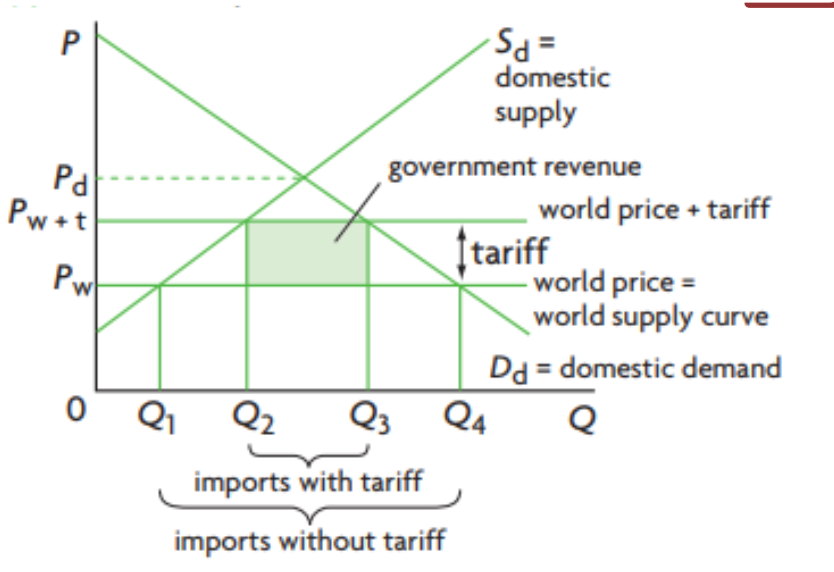
winners → less efficient domestic producers, efficient domestic producers, domestic employment, foreign producers, domestic income
losers → domestic consumers, foreign producers, domestic income distribution (regressive tax), global efficiency, resource allocation
regressive tax → same % tax but greater % of income depending on income level
ex: $100 tax is different %income for different people
welfare effects (economic well-being)
consumer surplus (CS) → reduced
transferred to government, producers, or just lost due to inefficiency and reduced consumption
producer surplus (PS) → increased
taken from consumers
social surplus is reduced (total)
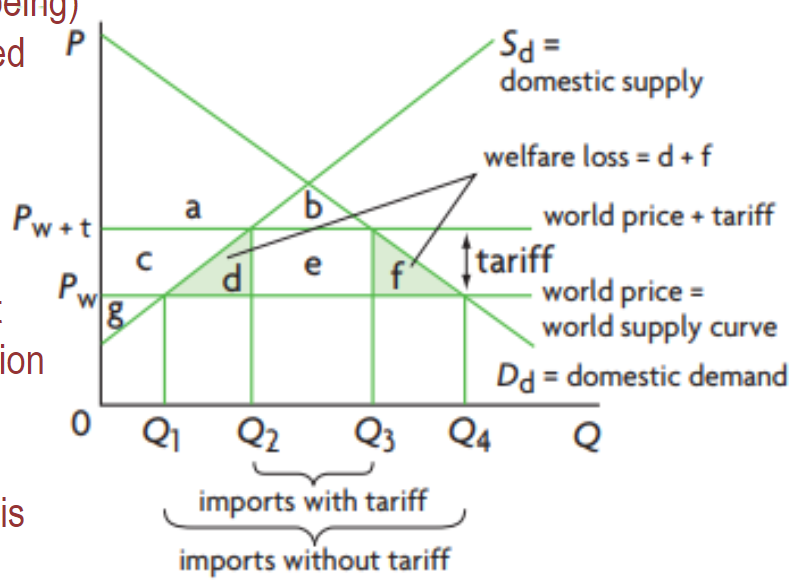
was → CS=a+b+c+d+e+f, PS=g
now → CS=a+b, PS=c+g. DWL (deadweight loss)=d+f, government revenue=e
Import Quotas (13/8/24)
legal limit on imports
limits quantity of a certain good over a particular period of time (ex: 1 year)
limits foreign competition for domestic industries
government issues a limited amount of “import licenses”
not license like driving license, more like tickets
recipients gain quota revenues (quota rents)
importers buy at Pw and sell at Pd (Pd>Pw) OR were selling at Pw and are now selling at Pd (foreign producers)
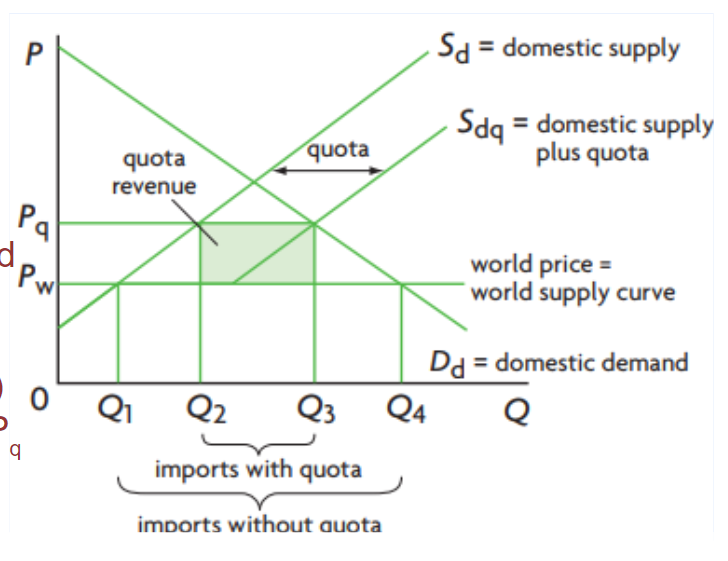
winners → efficient domestic producers, less efficient domestic producers, domestic employment, holders of licenses
losers → domestic consumers, domestic income distribution, global efficiency, resource allocation
neutral → government
no revenue generated, unlike tariffs
uncertain: foreign producers
might balance out (wins and losses)
Pd>Pw, but less quantity can be imported → depends if they have a license
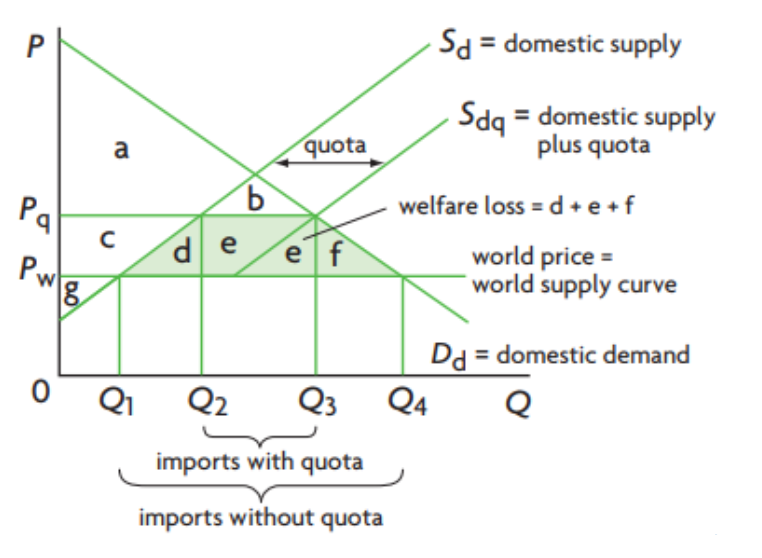
welfare effects (economic well-being)
CS is reduced
PS increases
was → CS=a+b+c+d+e+f, PS=g
now → CS=a+b, PS=c+g, DWL=d+e+f
DWL comes from inefficiency and reduced consumption
social surplus is reduced
Tariffs and Quotas (14/8/24)
tariff VS quota
same but tariffs generate tax revenues (less DWL)
therefore tariff > quota
tariffs
domestic consumers: higher price, lower quantity (-)
domestic producers: higher price, increased quantity (+)
government: increased revenue (+)
foreign producers: decreased quantity sold (-)
welfare loss: inefficiency and reduced consumption (-)
import quotas
domestic consumers: higher price, lower quantity (-)
domestic producers: higher price, increased quantity (+)
government: no impact (…)
foreign producers: higher price (?), decreased quantity (?)
welfare loss: inefficiency and reduced consumption and reduced CS (-)
same as tariff but it moves the supply curve, not the price (price moves with supply)
Production Subsidies (15/8/24)
subsidy → payment by the government to a firm for each unit of output produced
production subsidy → protects domestic firms from foreign competition
export subsidy → protects domestic firms that export to foreign countries
subsidy is the effect of production, not the cause (incentivizes)
production subsidy → protectionist measure that pays domestic firms for each unit of output produced
allows firms to remain competitive against imports
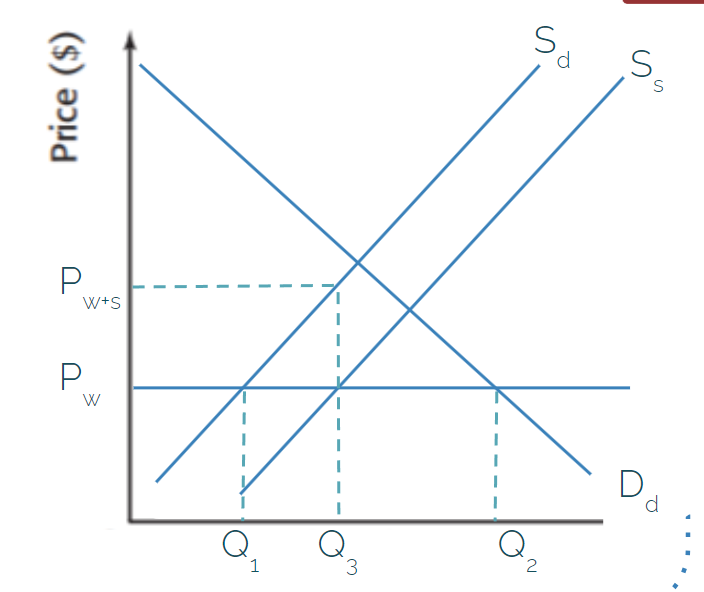
domestic consumers pay Pw, domestic firms receive Pw+s
shifts the product supply curve
by the amount per unit subsidy
all output for domestic market only
winners: efficient domestic producers, less efficient domestic producers, domestic employment
losers: foreign producers, government budget, taxpayers, global efficiency, resource allocation
neutral: domestic consumers
face the same price regardless
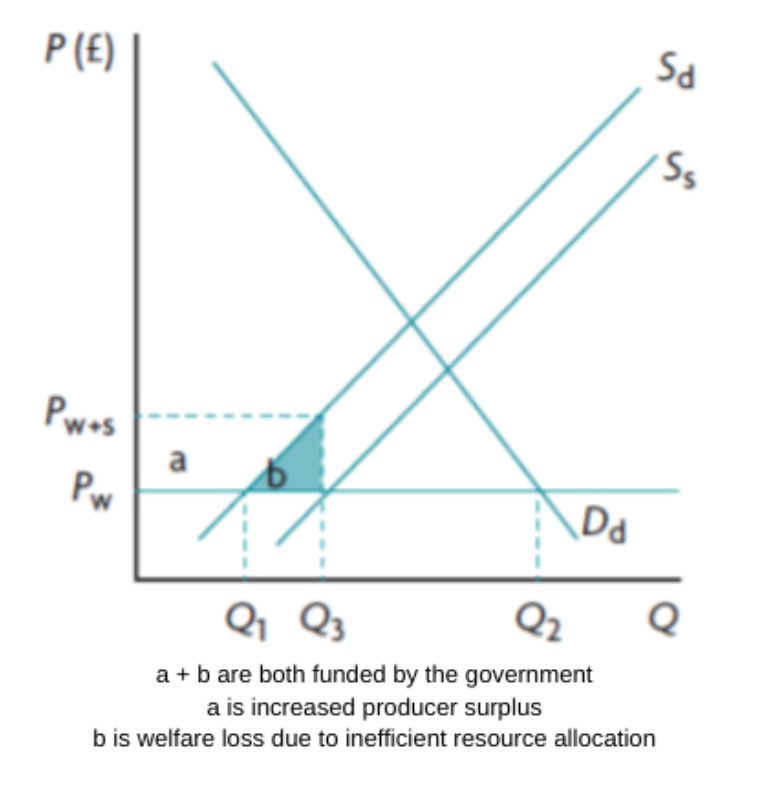
welfare effects
CS is not affected
PS increases at the expense of the government
DWL from inefficient production
Export Subsidies (19/8/24)
protectionist measure that pays domestic firms for each unit of output produced and exported
allows exporting firms to compete in foreign markets (Pw>Pd)
the world price stays the same, domestic supply curve shifts
increases domestic price to Pw+s
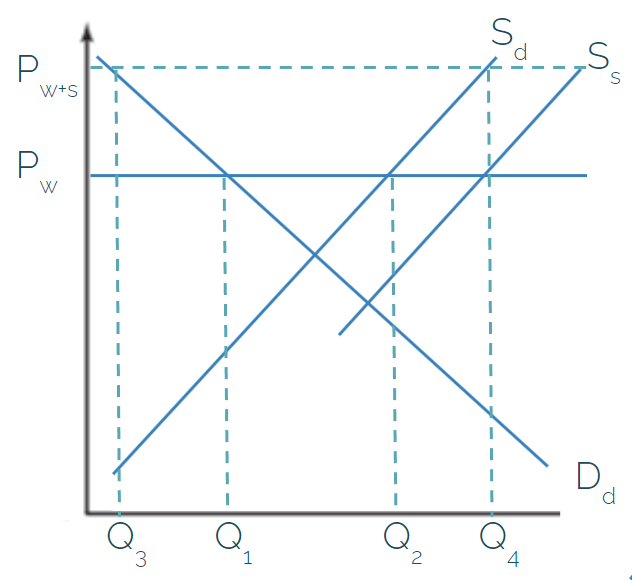
winners: efficient domestic producers, less efficient domestic producers, domestic employment
losers; domestic consumers, government budget, taxpayers, domestic income distribution, foreign producers, global efficiency, resource allocation
domestic producers face two prices when the export subsidy is implemented
foreign market → Pw + subsidy (Pw+s)
domestic market → Pw
domestic < foreign, so they choose the foreign market
forces domestic producers to match the foreign price, which increases price (Pw → Pw+s)
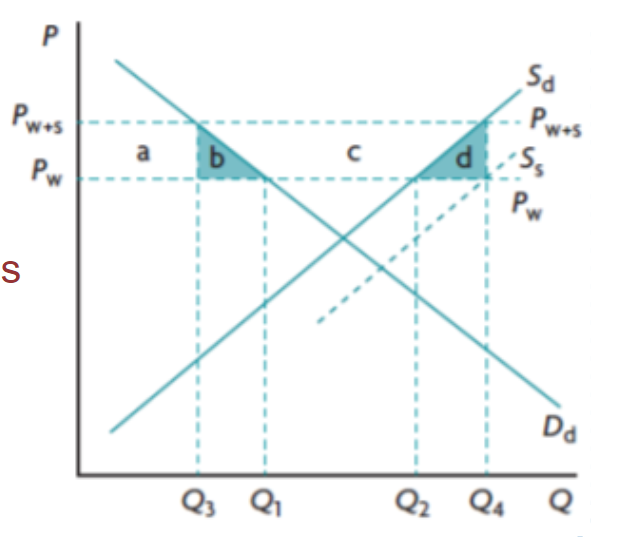
welfare effects
CS is reduced
higher price lower quantity
all transferred to firms (domestic producers)
PS is increased
at the expense of domestic consumers and government
social surplus is reduced
DWL → b+d
Exchange Rates (20/8/24)
the rate at which one currency can be exchanged for another (price of a currency)
number of units of a foreign currency that correspond to the domestic currency
necessary mechanism for international trade to exist
foreign exchange market (FOREX) → global marketplace that allows for the trading of one currency for another
necessary for international transactions
supports the continuous flow of money in and out of countries
individuals, firms, banks, governments, etc.
demand creates supply (only in FOREX)
foreign demand = domestic supply since it is exchanging, not buying
if I buy 10 USD for 150k IDR, the demand for USD increases as I am requesting USD in exchange for 150K IDR. at the same time, the supply for IDR increases as I am supplying IDR into the market in exchange for USD.
consequences of currency appreciation (increasing value of particular currency)
imports become cheaper and exports more expensive (decreased net exports)
worsening trade balance (increasing trade deficit)
decreasing cost-push and demand-pull inflationary pressure
cyclical unemployment
indeterminate impact on economic growth
indeterminate impact on living standards
consequences of currency depreciation (decreasing value of particular currency)
imports become more expensive and exports cheaper (increased net expors)
improving trade balance (decreasing trade deficit)
increasing cost-push and demand-pull inflationary pressure (factors of production)
job growth
indeterminate impact on economic growth
indeterminate impact on living standards
The Trade Protection Debate (22/8/24)
arguments for trade protection (trade restrictions) → despite known inefficiencies / misallocation of resources
infant industries → new domestic industry that is without economies of scale (in a developing country)
ex: pharmaceuticals
may disincentivize efficiency (-)
national security → some industries are essential for national defense
not an economic argument, but political/military
ex: aircraft, weapons
may be overextended (ex: steel) (-)
health and safety standards
imported goods might fall short (ex: food, medicine, etc.)
may actually be an administrative barrier (-)
LEDC (least economically developed country) diversification
opposite of specialization
LEDCs are often dependent on a limited number of commodities
difficult to identify (-)
anti-dumping
dumping: selling a good in an international market below the cost of production
due to export subsidies
difficult to justify → may actually be administrative barriers (-)
balance of payments correction
outflow of money > inflow of money
imports > exports
risk of retalliation (-)
arguments against trade protection
misallocation of resources
less efficient markets
retalliation
potential for trade war
increased costs
raw materials and capital are more costly
higher prices
true for tariffs, quotas, and administrative barriers
less Qd
less choice
fewer options to satisfy needs/wants
result of decreased competition
domestic firms lack incentive to become more efficient
lack of competition permits inefficiencies
reduced export competitiveness
inefficient firms must charge more than foreign competition
foreign demand for products is typically greater than domestic
Preferential Trade Agreements (PTA) (26/8/24)
form of economic integration (trade policies that increase interdependence)
agreement to lower/remove trade barriers
ensures easier access to specific markets in 2+ member countries
may include cooperation on additional issues (ex: labor/environmental standards)
promotes trade liberalization
bilateral trade agreement (mutual agreement between 2 countries)
regional trade agreement (according to geographic region)
multilateral trade agreement (legally binding agreement between 3+ countries)
accomplished through the World Trade Organization (WTO)
Administrative Barriers (27/8/24)
protectionist measures that impose bureaucratic standards and regulations on foreign firms
‘red tape’ checks and procedures that create obstacles for imports
overly concerned with procedure at the cost of efficiency/common sense
costly → both time and money
ex: customs inspections/valuations, packaging requirements, strict health/safety/environmental
winners: efficient domestic producers, less efficient domestic producers, domestic employment
losers: domestic consumers, foreign producers, global efficiency, resource allocation
Trading Blocs (2/9/24)
group of countries that have agreed to reduce barriers to trade to encourage free/freer trade
amongst those in the bloc
includes free trade areas, customs unions, and common markets
free trade area (FTA)
group of countries agree to eliminate trade barriers among members
most common intergration → relatively low degree
members can pursue their own policies with non-member countries
creates dependence upon the country with the lowest non-member barriers to trade (-)
I don’t like country O but country A does and I’m in a FTA with A so I’ll get O’s products from A
ex: USMCA, CAFTA, ANZFTA, EFTA
customs union
group of countries agree to eliminate trade barriers among members AND adopt a common policy towards all non-member countries (FTA+)
members act together in all negotiations with non-members
no need for ‘rules of origin’
more complicated (-)
ex: Mercosur, GCC, ECOWAS
common market
group of countries agree to eliminate trade barriers among members AND adopt a common policy towards all non-member countries AND agree to eliminate all restrictions on movement of the factors of production (FTA++)
labour and capital can move freely across borders
most efficient allocation of factors of production
extremely complicated → countries lose autonomy (-)
ex: EU, SACU
possible advantages
increased competition
expansion into larger markets
economies of scale
lower prices and greater choice
increased investment
improved resource allocation
productive efficiency and economic growth
stronger bargaining power (with non-member countries)
peace and political stability
possible limitations
inferior to WTO’s multilateral approach
aims for free trade for all
unequal distribution of gains and some losses
loss of sovereignty
Trade Creation and Trade Diversion (2/9/24)
trading blocs change patterns of trade → through reduced trade barriers
trade between non-member nations is discouraged → through trade barriers
trade creation → higher cost products are replaced low cost imports through a customs union
original products may have imported or domestically produced
combines comparative advantage and trade liberalization
increases consumption, greater productive efficiency, greater allocative efficiency, increases social welfare
trade diversion → lower cost imports (from non-member countries) are replaced by higher cost imports (from member countries) through a customs union
is an argument against trading blocs and for multilateral trade liberalizations (WTO)
decreases consumption, productive inefficiency, allocative inefficiency, decreases social welfare
long-term benefits still (likely) outweigh the costs
political relationships
economic integration
if I trade within my trading bloc, member countries will buy my products too
Monetary Union (3/9/24)
a common market that requires market countries to adopt a single common currency and a common central bank (FTA+++)
responsible for one monetary policy
has strict membership requirements
ex: rate of inflation, interest rate, debt to GDP ratio
many similarities to a fixed exchange system
RWE → EU (eurozone countries)
Evaluation of monetary union (5/9/24)
advantages
single currency encourages price transparency
allows consumers and firms to easily compare prices
promotes competition and efficiency
single currency eliminates transaction costs
conversion fees are always paid → not anymore
encourages trade and investment → supports allocative efficiency
single currency eliminates exchange rate risk and uncertainty
exchange rates typically fluctuate
benefits importers, exporters, consumers, and investors
encourages trade and investment → supports allocative efficiency
single currency promotes inward investment
encourages investment from outsiders → appeal of expanded market and single currency → supports economic growth
low rate of inflation give rise to low interest rates
member countries are deeply concerned with inflation (single monetary policy)
to remain competitive
encourages investment → supports economic growth
encourages consumption spending → increases output
disadvantages
loss of sovereignty
loss of domestic monetary policy
each member country is affected differently by shared monetary policy
varying positions in the business cycle
varying levels of inflation/unemployment
loss of exchange rates as a mechanism for adjustment
unable to depreciate/devalue
when seeking balance of trade / trying to counter inflation
convergence requirements constrain fiscal policy
economic/financial requirements
potentially limiting expansionary fiscal policy
ex: debt deficit limits
The World Trade Organization (WTO) (9/9/24)
the only global international organization dealing with the rules of trade between countries
responsible for WTO agreements
help producers, exporters, and importers conduct their business
negotiated and signed by the bulk of the world’s trading countries and ratified in their parliaments
objectives → lengthy and complex legal trade documents that encourage:
non-discrimination, open trade, predictability + transparency, fair competition, support for LDCs, protection of the environment, inclusion
six functions:
administrating WTO agreements
forum for trade negotiations
handling trade disputes
monitoring national trade policies
cooperation with other international organizations
technical assistance and training for developing countries
criticisms
WTO allows unfavourable treatment of LDCs
MDCs continue to subsidize agricultural products
MDC → more developed countries
MDCs receive greater tariff reductions
exposed to non-tariff barriers
protection of intellectual property increases costs of technology
MNCs not required to purchase supplies locally
MNC → multinational company
WTO fails to distinguish between developed and developing economies
only recognize/protect LDCS → LEAST
developing countries _> infant industry ptoection
developing countries may need to diversify
reduce reliance on primary commodities
WTO ignores environmental issues
encourages removal of trade barriers against countries with low standards
permits subsidies on harmful products (ex: agriculture, coal, transporation)
WTO ignores labour issues
ex: child labour
WTO members have unequal bargaining power
LDCs often silent in fear of retalliation
includes agenda setting
Floating exchange rates (18/9/24)
an exchange rate determined entirely by market forces
supply and demand determine equilibrium (Qd=Qs)
no government intervention
no central bank interaction
free float / flexible exchange rate
downward sloping demand curve
currency demand occurs when there are inflows of foreign currencies into a country
upward sloping supply curve
currency supply occurs when there are outflows of domestic currency out of a country
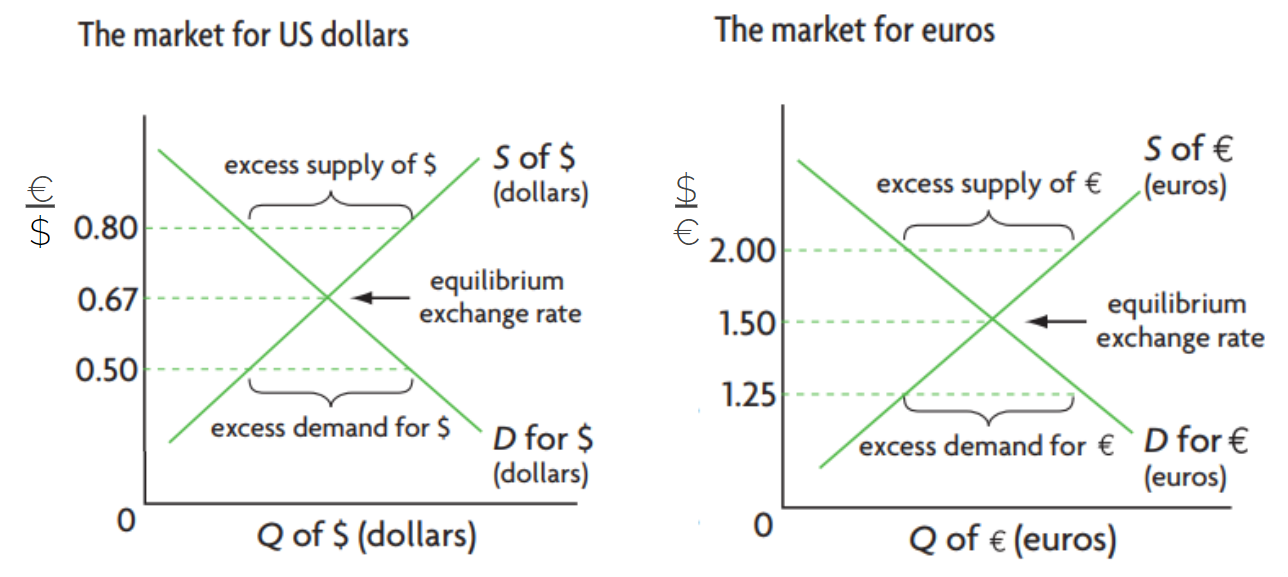
prices are reciprocals of one another
the quantity on the x axis will always be the denominator on the y axis
currency appreciation → increase in currency’s value (in relation to another)
caused by increased demand or decreased supply
increase in price (value)
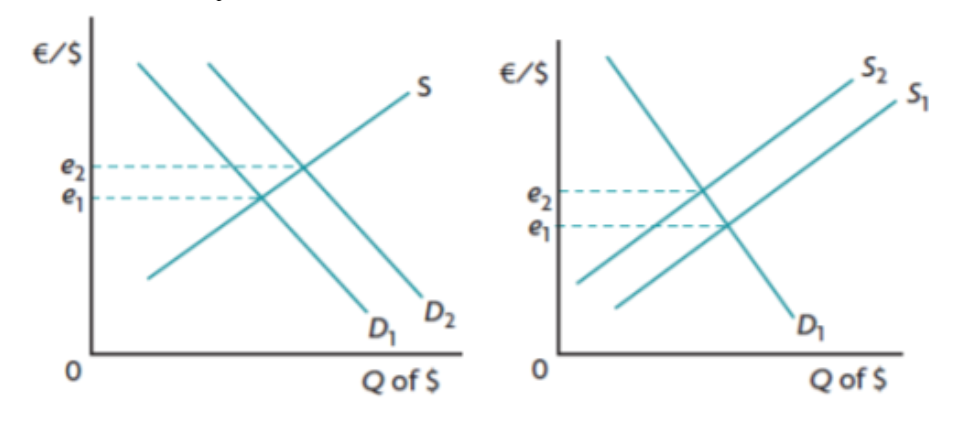
currency depreciation → decrease in currency’s value (in relation with another)
caused by decreased demand or increased supply
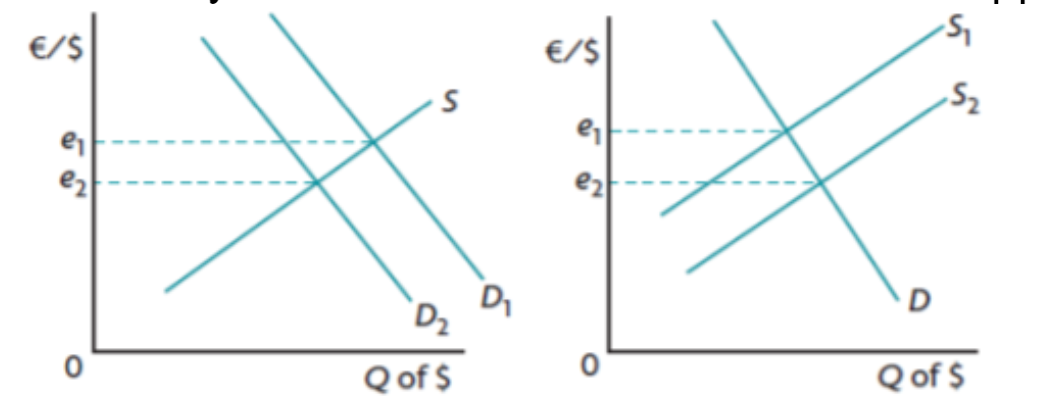
causes of change in demand and supply for a currency
foreign demand for exports
goods and services
domestic demand for imports
goods and services
inward/outward foreign direct investment
expanding operations of MNCs
inward/outward portfolio investment
financial instruments
remittances
overseas nationals send money back
speculation
currency as a financial asset
saving in hopes of appreciation
relative inflation rates
general price levels
relative interest rates
price of money
relative growth rates
increased wages and consumption
central bank intervention
reserves of FOREX currencies
strengths
policy makers have great flexibility → no need for central banks to hold foreign reserves
balance of payments is achieved automatically
automatic adjustments to excess demand or supply
naturally provides downward pressure on high inflation
limitations
uncertainty for stakeholders
currency speculation can be destabilizing
Fixed exchange rates (19/9/24)
an exchange rate that is fixed by a country’s central bank and not permitted to change freely
“pegging” → verb for definition above (relative to another country’s currency)
requires constant central bank intervention
manipulating demand/supply of currencies → mostly buying/selling reserve currencies
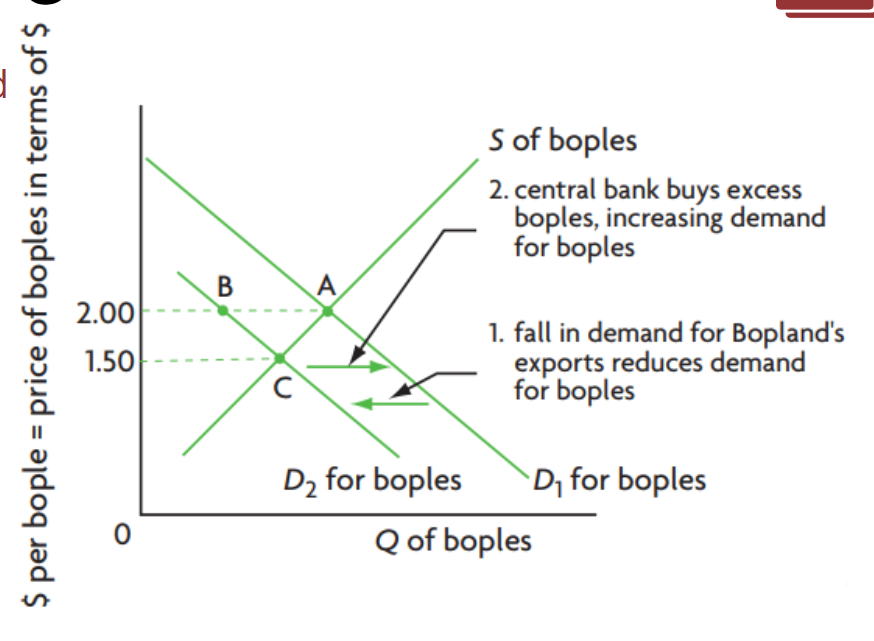
fall in demand for exports reduce demand (D1→D2)
central bank buys excess of the country’s currency, increasing demand (D2→D1)
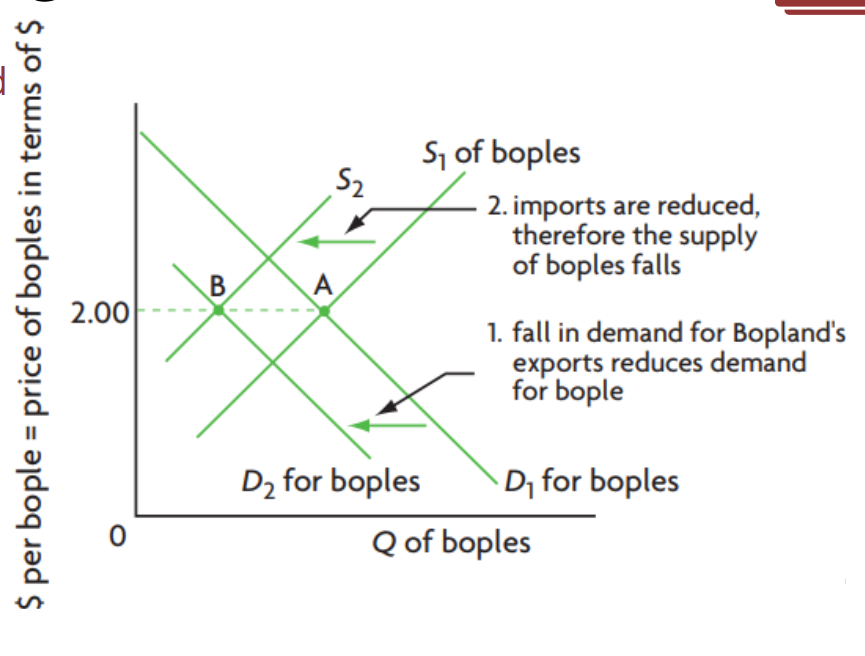
fall in demand for exports reduce demand (D1→D2)
imports are reduced, so supply of the currency falls (S1→S2)
central bank must respond to excess demand for currency
caused by increased demand or decreased supply
ex: increasing exports or decreasing imports
can buy foreign currency (domestic supply)
central bank must respond to excess supply of currency
caused by increased supply or decreased demand
ex: increasing imports or decreasing exports
can buy domestic currency (using foreign reserve supply)
until they run out of foreign currencies
additional measures to maintain a fixed rate
response to excess supply of domestic currency:
increase interest rates
attracts inflow of foreign currency
(-) contractionary monetary policy may cause recession
borrow from abroad
access to foreign currency
(-) increasing foreign debt
efforts to limit imports
decreases excess domestic supply
contractionary policy to decrease spending → (-) potential recession
trade protection policies → (-) potential retalliation by trade partners
devaluation of a currency
officially and deliberately decreasing the value of a pegged currency
looks similar to depreciation of a floating currency
results in cheaper exports and more expensive imports
revaluation of a currency
officially and deliberately increasing the value of a pegged currency
looks similar to appreciation of a floating currency
results in cheaper imports and more expensive exports
strengths
high degree of certainty for stakeholders
very little speculation activity
limitations
requires constant monitoring to eliminate disequilibrium
requires central banks to hold sufficient FOREX reserves
policy makers have little flexibility → most maintain fixed exchange rate
requires contractionary fiscal policies to keep exports competitive during inflation
imbalance of payments is not easily corrected
Managed exchange rates (26/9/24)
an exchange rate determined by market forces but periodically influenced by a country’s central bank
“managed float”
combines floating and fixed systems
closer to floating
intervention aims for short term stability
prevention of large and abrupt fluctuations
fluctuations discourage investment and spending
typically buying/selling currencies
generally done within upper and lower ‘bands’
freedom to float within a determined range
consequences of overvalued currencies (greater than equilibrium free market value)
cheaper imports → cheaper capital and raw materials
helpful for LDCs to grow manufacturing
(-) expensive exports, worsening trade balance, increased competition for domestic firms, domestic unemployment
may need to be devalued
consequences of undervalued currencies (lower than equilibrium free market value)
considered cheating (unfair competitive advantage) → “dirty float”
cheaper exports, growth of export industries, job creation
(-) expensive imports, cost-push inflation
may need to be revalued
both overvalued and undervalued currencies only occur in fixed and managed systems, not free floats
BOP accounts (14/10/24)
BOP → balance of payments
record of all transactions between a country’s residents and the rest of the world
over a defined period (ex: one quarter)
households, firms, and government
ex: imports/exports, travel, financial investments, foreign direct investment, etc.
“balance of international payments”
credits = debits
credit → inflow, debit → outflow
inflow of payments received (credits) create foreign demand for country’s currency which is the supply for foreign currency
outlfow of payments made (debits) create domestic supply of nation’s currency which is the demand for foreign currency
BOP consists of three accounts
current account (4)
balance of trade in goods (X-M)
balance of trade in services (X-M)
income (inflows - outflows)
current transfers (inflows - outflows)
capital account (2)
capital transfers (inflows - outflows)
transactions in non-produced, non-financial assets (inflows - outflows)
capital account is relatively small and unimportant
financial account (4)
(foreign) direct investment (inflows - outflows)
portfolio investment (inflows - outflows)
reserve assets (inflows - outflows)
official borrowing (inflows - outflows)
The balance of payments (15/10/24)
there is interdependence between the three accounts
a deficit in one account will be offset by a surplus in another
sum of the three accounts will always be zero (“zero balance”)
credits match the debits; surpluses match the deficits
current account = -(capital account + financial account)
current = -(capital + financial + errors and omissions)
if a country has a current account deficit (exports < imports)
inflows (credits) < outflows (debits)
financial (and capital) accounts surplus provides foreign exchange to pay for deficit
zero balance is achieved
country consumes beyond PPC (more than they can produce)
if a country has a current account surplus (exports > imports)
inflows (credits) > outflows (debits)
surplus provides foreign exchange used to pay for financial (and capital) deficit/spending
zero balance is achieved
country consumes beyond PPC
The BOP and exchange rates (17/10/24)
relationship between current account and exchange rate
floating exchange rate system
current account deficit causes downward pressure on the exchange rate
increasing debits require outflows of domestic currency (increased supply = decreased value)
current account surplus causes upward pressure on the exchange rate
inflows of foreign currency must be exchanged (increased demand = increased value)
managed exchange rate system
central bank responds to current account surplus by buying foreign currency
done to avoid appreciation
central bank responds to current account deficit by selling foreign currency
done to avoid depreciation
fixed exchange rate system
central bank responds to current account surplus by increasing debits
ex: buy foreign currency, decrease interest rates, lend abroad
done to avoid revaluation
central bank responds to current account deficit by increasing credits
ex: sell foreign currency, increase interest rates, borrow from abroad
also can increase debits by limiting imports
done to avoid devaluation
relationship between financial account and exchange rate
financial account surplus is typically caused by investment in domestic economy from outside
foreign direct investment or response to high interest rates
increased demand for currency increases its value
financial account deficit is typically caused by investment in foreign economies
foreign direct investment or response to high interest rates
increased supply for currency decreases its value
Current account deficits and surpluses (29/10/24)
consequences of persistent current account surpluses (extended trade surplus, balanced with financial account)
low domestic consumption
production > consumption → lower standard of living
upward pressure on exchange rate
damage on domestic economy
insufficient domestic investment
caused by financial account deficit
reduced export competitiveness
due to currency appreciation
unemployment
workers begin to lose jobs
(+) downward pressure on price levels
demand-pull and cost-push
consequences of current account deficits (extended trade deficit, balanced with financial account)
downward pressure on exchange rate
imported inflation (from countries with higher prices)
need for high interest rates to attract inflows
contractionary monetary policy → discourages investment
foreign ownership of domestic assets (ex: U.S.)
satisfies need for credits in financial account
increasing levels of debt
risk of default → cannot pay the debt
poor international credit rating
considered less credit-worthy
cost of paying interest on loans (debt servicing)
opportunity cost
painful demand management policies
contractionary policies to limit imports (debits)
lower economic growth
result of contractionary policies and government paying interest on loans
policies to correct persistent current account deficits
expenditure reducing policies (aims to limit AD)
contractionary policies → reduces output, income, consumption, imports
(+) lower rate of inflation → more competitive exports
(-) likely recession → higher interest rates put upward pressure on exchange rates
expenditure switching policies (from imported to domestic goods)
trade protection
(-) retalliation, higher domestic prices, lower domestic consumption, misallocation of resources
depreciation
(+) benefits export industries
(-) demand-pull, cost-push inflation
supply-side policies (increase competitiveness)
ex: limit power of trade unions, reduce minimum wage/corporate taxes, deregulation
(+) greater potential output, downward pressure on inflation
(-) requires a lot of time
Marshall-Lerner condition → measure of effectiveness of devaluation/depreciation to reduce a trade deficit
if sum of the PEDs of imports and exports is greater than 1, devaluation/depreciation will improve trade balance
if sum of the PEDs of imports and exports is less than 1, devaluation/depreciation will reduce trade balance
if sum of the PEDs of imports and exports is equal to 1, devaluation/depreciation will not affect trade balance
suggests that a devaluing/depreciating country may initially experience a worsening trade balance, followed by a shrinking deficit, then a trade surplus
“J-curve” effect
result of initially low PED (due to time lags) that increases with time
 Knowt
Knowt